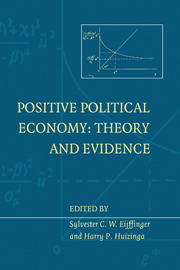Book contents
- Frontmatter
- Contents
- List of figures
- List of tables
- List of contributors
- Foreword
- Introduction
- I Monetary institutions and policy
- 1 Reputational versus institutional solutions to the time-consistency problem in monetary policy
- 2 Reciprocity and political business cycles in federal monetary unions
- 3 The ultimate determinants of central bank independence
- 4 Central bank autonomy and exchange rate regimes – their effects on monetary accommodation and activism
- 5 Uncertainty, instrument choice, and the uniqueness of Nash equilibrium: microeconomic and macroeconomic examples
- 6 New empirical evidence on the costs of European Monetary Union
- II Exchange rate policy and redistribution
- Index
2 - Reciprocity and political business cycles in federal monetary unions
from I - Monetary institutions and policy
Published online by Cambridge University Press: 05 September 2013
- Frontmatter
- Contents
- List of figures
- List of tables
- List of contributors
- Foreword
- Introduction
- I Monetary institutions and policy
- 1 Reputational versus institutional solutions to the time-consistency problem in monetary policy
- 2 Reciprocity and political business cycles in federal monetary unions
- 3 The ultimate determinants of central bank independence
- 4 Central bank autonomy and exchange rate regimes – their effects on monetary accommodation and activism
- 5 Uncertainty, instrument choice, and the uniqueness of Nash equilibrium: microeconomic and macroeconomic examples
- 6 New empirical evidence on the costs of European Monetary Union
- II Exchange rate policy and redistribution
- Index
Summary
Introduction
A characteristic of monetary unions is that the governance of money has a federal structure. This is reflected in the fact that the central bank council consists of representatives of the member states of the union, possibly together with representatives of the federal government, if such a government exists, or with appointees of the central decision-making body of the union. For example, the Federal Open Market Committee (FOMC) has the presidents of five regional Federal Reserve Banks as voting members together with seven governors appointed by the US President and confirmed by Congress. The council of the Bundesbank consists of the presidents of all state central banks and the members of the Bundesbank Board. Where monetary unions do not coincide with political unions, such as in the Caribbean and in the African monetary unions, representatives of the independent member states sit on the council and decide on monetary policy collectively. This will also be true for the European Central Bank (ECB) according to the design of the Maastricht Treaty.
The federal structure of such unions raises the question of how to distribute the power over monetary policy between the center and the parts of the union. Von Hagen and Süppel (1994a, b) show that central appointees deliver more efficient monetary stabilization policies than state representatives. However, Von Hagen and Süppel also show that a central bank council of state representatives is less likely to produce political business cycles and, therefore, produce a lower long-run rate of inflation than central appointees.
- Type
- Chapter
- Information
- Positive Political EconomyTheory and Evidence, pp. 29 - 43Publisher: Cambridge University PressPrint publication year: 1998
- 1
- Cited by



